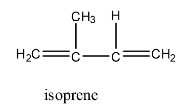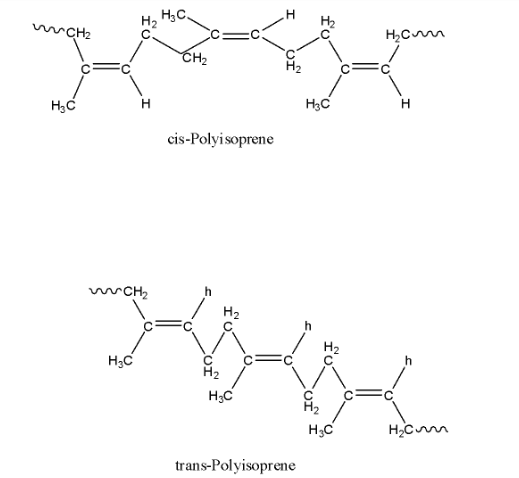
What is the monomer unit of natural rubber?
(a)- Isoprene
(b)- Ethane
(c)- Neoprene
(d)- Tetrafluoroethene
Answer
143.4k+ views
Hint: The natural rubber is chemically called Polyisoprene. The cis-polyisoprene is called natural rubber and trans-isoprene is called Gutta-percha.
Complete step by step answer:
There are 2 two types of rubber: natural rubber and synthetic rubber.
The natural rubber has remarkable elasticity and undergoes long-range reversible extension even under a relatively small applied force. That is why it is also called an elastomer. It is manufactured from latex which is a colloidal solution of rubber particles in water. Latex is obtained by making an incision in the bark of rubber trees found in tropical and subtropical countries such as Southern India (Kerala, Tamil Nadu, Karnataka, etc), Malaysia, Sri Lanka, etc.
Chemically, natural rubber is a linear 1,4-addition polymer of isoprene (i.e., 2-methyl-1,3-butadiene).
The structure of isoprene is:

And the polymerization reaction of isoprene to form Polyisoprene is given below:

Since each repeating unit in polyisoprene contains a double bond, it may have either a cis- or a trans- orientation. Actually, in natural rubber, all the double bonds have cis- stereochemistry. In other words, natural rubber is cis-polyisoprene. In contrast, synthetic rubber (gutta percha) is trans-polyisoprene. The structure of natural rubber and gutta-percha is given below:

Inspection of the structure of natural rubber reveals that there are no polar groups/substituents and hence intermolecular forces of attraction are only weak van der Waals interaction. These forces are further weakened because of the cis-configuration of all the double bonds which does not allow the polymer chains to come close enough for effective interactions. Thus, cis-polyisoprene does not have a straight-chain but has a coiled structure. As a result, it can be stretched like a spring. Thus, the natural rubber is elastic.
Hence, the correct answer is an option (a)- Isoprene.
Note: Due to the coiled structure, natural rubber does not fit closely in the crystal lattice and hence is considered to be non-crystalline. In contrast, due to highly zig-zag structure, gutta-percha fits closely in the crystal lattice and hence, is considered as crystalline.
Complete step by step answer:
There are 2 two types of rubber: natural rubber and synthetic rubber.
The natural rubber has remarkable elasticity and undergoes long-range reversible extension even under a relatively small applied force. That is why it is also called an elastomer. It is manufactured from latex which is a colloidal solution of rubber particles in water. Latex is obtained by making an incision in the bark of rubber trees found in tropical and subtropical countries such as Southern India (Kerala, Tamil Nadu, Karnataka, etc), Malaysia, Sri Lanka, etc.
Chemically, natural rubber is a linear 1,4-addition polymer of isoprene (i.e., 2-methyl-1,3-butadiene).
The structure of isoprene is:

And the polymerization reaction of isoprene to form Polyisoprene is given below:

Since each repeating unit in polyisoprene contains a double bond, it may have either a cis- or a trans- orientation. Actually, in natural rubber, all the double bonds have cis- stereochemistry. In other words, natural rubber is cis-polyisoprene. In contrast, synthetic rubber (gutta percha) is trans-polyisoprene. The structure of natural rubber and gutta-percha is given below:

Inspection of the structure of natural rubber reveals that there are no polar groups/substituents and hence intermolecular forces of attraction are only weak van der Waals interaction. These forces are further weakened because of the cis-configuration of all the double bonds which does not allow the polymer chains to come close enough for effective interactions. Thus, cis-polyisoprene does not have a straight-chain but has a coiled structure. As a result, it can be stretched like a spring. Thus, the natural rubber is elastic.
Hence, the correct answer is an option (a)- Isoprene.
Note: Due to the coiled structure, natural rubber does not fit closely in the crystal lattice and hence is considered to be non-crystalline. In contrast, due to highly zig-zag structure, gutta-percha fits closely in the crystal lattice and hence, is considered as crystalline.
Recently Updated Pages
How to find Oxidation Number - Important Concepts for JEE

How Electromagnetic Waves are Formed - Important Concepts for JEE

Electrical Resistance - Important Concepts and Tips for JEE

Average Atomic Mass - Important Concepts and Tips for JEE

Chemical Equation - Important Concepts and Tips for JEE

Concept of CP and CV of Gas - Important Concepts and Tips for JEE

Trending doubts
JEE Main Exam Marking Scheme: Detailed Breakdown of Marks and Negative Marking

Types of Solutions

Physics Average Value and RMS Value JEE Main 2025

Geostationary Satellites and Geosynchronous Satellites - JEE Important Topic

JEE Main 2025: Conversion of Galvanometer Into Ammeter And Voltmeter in Physics

JEE Main Chemistry Online Mock Test for Class 12

Other Pages
JEE Advanced 2025: Dates, Registration, Syllabus, Eligibility Criteria and More

NCERT Solutions for Class 12 Chemistry Chapter 3 Chemical Kinetics

NCERT Solutions for Class 12 Chemistry Chapter 9 Amines

NCERT Solutions for Class 12 Chemistry Chapter 4 The D and F Block Elements

JEE Advanced 2025 Revision Notes for Practical Organic Chemistry

JEE Advanced Course 2025: Subject List, Syllabus and Foundation Course




